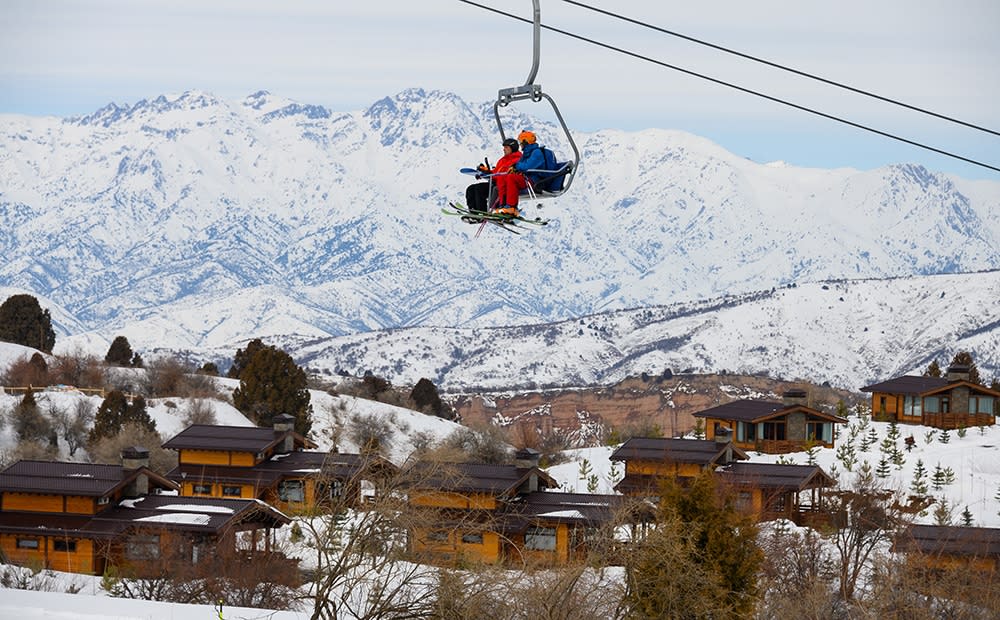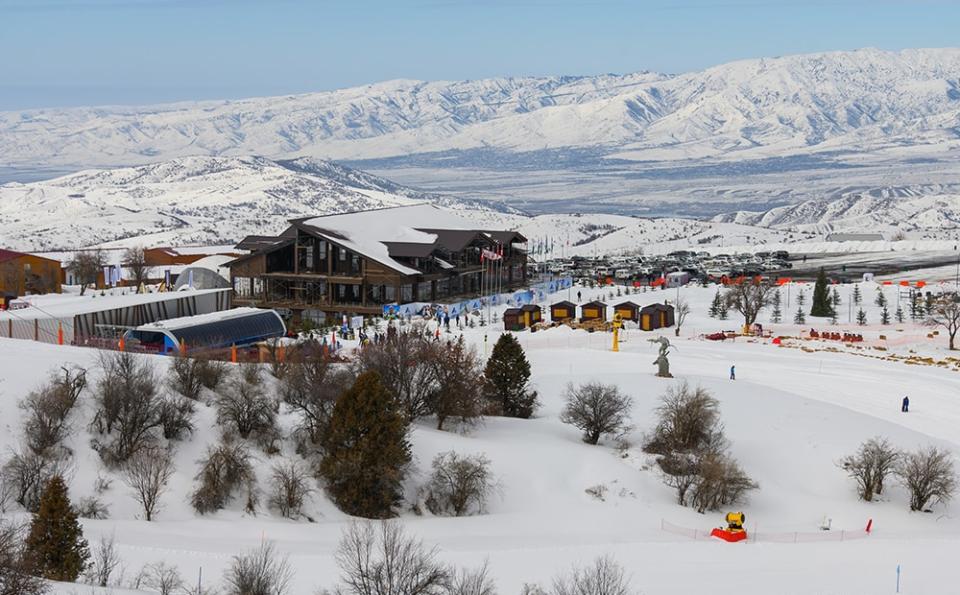A skier's secret: The untapped ski destination in Uzbekistan with snow 'unlike anything else'

Uzbekistan is not the first country that springs to mind when planning a ski trip, but, following the debut of the resort of Amirsoy in the Western Tian Shan mountains last season, it should be all eyes east for the new ski frontier once international travel is back on the cards.
In what is surely one of the world’s most ambitiously paced mountain developments, Tashkent businessman Rashvan Abdullaev has single-handedly financed and created a state-of-the-art ski resort from scratch in just three years.
Abdullaev, a 44-year-old who made his money in oil and gas, took up skiing in 2015, primarily to conquer his fear of heights. He learnt in Sochi, Russia, home of the 2014 Winter Olympics, since at the time the only skiing in Uzbekistan was a rudimentary heliski operation opened in the early Nineties and a couple of Soviet era resorts – Chimgam and Beltersay. Located close to each other in the Chatkal mountains, they are serviced by ancient two-seater chairlifts. Abdullaev felt sure he could raise the bar.
His first step, in 2017, was to instruct mountain-resort planner Ecosign, which counts Andermatt in Switzerland and Whistler in Canada among its clients, to scope out terrain in the Chatkals. Around 70km from Tashkent, the Uzbek capital, they are part of the Western Tian Shan “heavenly mountains” chain that forms the spine of Central Asia.
Sandwiched between Kazakhstan to the north and Kyrgyzstan to the south, there can be few more beautiful sights than this vast undeveloped mountainscape, matched only perhaps by the scale of Abdullaev’s ambition. Ecosign’s flyovers quickly homed in on the north-facing spurs of the Chatkal ridge, in particular the 2,290m peak of Amirsoy, not far from Chimgam and Beltersay. The problem was a complete lack of water or power, and the only road in was a cattle track.

Undeterred, Abdullaev negotiated the land deals and the infrastructure, with the grand ambition of opening Amirsoy in December 2018. In October 2018 he engaged Andorra-based ski management company PGI on a three-year contract, but slow progress on roads and electricity meant he had to postpone the opening. However, one year and $100 million (£80 million) of his own funds later, he had the foundations of a world-class ski resort.
For the 2019/20 ski season a two-stage, eight-person gondola and a four-seater chairlift were in place, servicing 15km of piste. The plan is to build up to 14 lifts, and extend the existing 2,224 acre ski area by 12,335 acres, and the pistes to 140km.
When I visited, in mid-February 2020 before the coronavirus pandemic struck, Amirsoy had already had more than 150,000 visitors, mostly from the local area. While it was averaging a thousand skiers a day, it was attracting three times that as pedestrians. There was a carnival atmosphere at the top of the gondola, with the local gold-toothed ladies dancing with their children as we skiers clipped into our bindings.
“When we first opened, people would think they were in a different country,” said Abdullaev when we met at the base of the gondola. “Amirsoy is so different from anything they had seen before.” His goal is not only to develop the biggest ski resort in Central Asia, but also to foster ski culture, and his methods are astute. Non-skiers come for sightseeing, snow-tubing and snowmobile rides, and leave with the idea of snow sports embedded in their minds. At the start of the season there were 10 ski instructors, by February it was 30, with local schools bringing children for lessons.
“What he has achieved is extraordinary,” Thomas Torjensen, PGI’s head of operations, told me, “and it’s only possible because all the decisions were being made by one man.” Torjensen, formerly a general manager of Courchevel in France, continued, “His vision is very intelligent – there are four million potential skiers nearby in Tashkent and the quality of the snow is unlike anything else. And I’ve skied everywhere.”
I am inclined to agree. I have only come across snow as good as this when skiing in Japan, or in the depths of British Columbia in Canada. I talked to Agustina Sosa, an Amirsoy ski patroller from Argentina, who has worked European ski resorts for 20 years: “The quality of the snow is unreal. Today it’s plus 6ºC at the top but the snow is still perfect. Everyday we analyse the snowpack; the crystals are the same [as in Europe] but somehow they keep their form, it’s black magic.”
Or white magic perhaps. Either way it’s pretty special.
Last season the only accommodation at Amirsoy was a slopeside complex of serviced chalets, with roaring log fires and marble bathrooms. The hub of the base area is an American-style lodge with reception, shops and ski hire; more shops plus bars, restaurants and a four-star hotel, along with a spa and restaurant for the chalets, are planned in the near future. There are also restaurants and bars spread around the ski area, housed in geodomes and serving dishes like Plov, a classic lamb pilau that makes a mighty mountain lunch.

The next phase of resort development will be a separate base area with three restaurants, a hotel, a chondola lift with a mix of gondola cabins and chairs, and five more pistes, taking the total pisted terrain to 27km. It was planned for winter 2020/21, but was postponed because of coronavirus. In the meantime, while pistes are quite limited, there is plenty of scope for off piste.
Multiple tree-lined valleys are accessible directly from the gondola, with short hikes opening up flanks of virgin powder; using touring skis to skin uphill accesses even more. We skinned up Amirsoy’s adjacent peak, Maygashkan, to check out terrain that will be opened up by the chondola, and the potential was breathtaking. And when that gondola is installed, it will open up another ridge to ski tourers.
Looking back across the valley as I left Amirsoy, its full extent was clear. With three ridges ripe for expansion to the west and all the terrain between Amirsoy and Beltersay to the east, this could easily grow to be bigger than Sochi’s Rosa Khutor – currently the largest ski resort in Central Asia with 102km of pistes.
Amirsoy is part of a wider narrative on the evolution of Uzbekistan. Five years ago travelling here was like stepping behind the Iron Curtain. Tashkent was formerly the fourth largest city in the USSR, and even though the country declared independence in 1991, it remained firmly in the grip of President Islam Karimov, the “Father of the Nation”, who ruled very much in Soviet style.

Under his command, Uzbekistan was almost completely isolated; tourists needed an official letter of invitation to visit. Since Karimov’s death in 2016, however, there has been an “Uzbek Spring” under new president Shavkat Mirziyoyev.
Drawing comparisons as a moderniser to Mikhail Gorbachev, the Soviet president who oversaw the dismantling of the USSR in 1991, Mirziyoyev has framed his presidency around the twin pillars of investment and tourism. During 2017 and 2018, Uzbekistan saw 44 per cent growth in external investment, and today 86 countries can visit visa-free, including the UK. Trade across the country’s land borders is growing exponentially and there’s almost as much construction in Tashkent as a boom city in the United Arab Emirates.
In February 2020, we landed in Tashkent at sunrise after a seven-hour flight from Heathrow, and my first impressions were of a country very much open for business, with large signs in English displayed in the new international terminal, built in 2018. While most tourists are summer visitors coming to explore the famed Silk Route cities of Bukhara and Samarkand, I am convinced that thanks to Rashvan Abdullaev’s foresight, winter-sports enthusiasts will soon start arriving, ready to carve their own slice of heaven in the mountains.
Essentials
While no UK tour operators offer ski packages accommodation and transfers are easily arranged directly with Amirsoy (amirsoy.com; 00 998 (71) 200 22 90). The local currency is the Uzbekistani Som, but the resort largely operates in US dollars. A stay at Le Chalet by Amirsoy starts at US$400 (£325) a night B&B for a two-bedroom cabin sleeping up to four people; four-bedroom cabins sleeping up to eight start at $600. Double rooms at the upcoming four-star Apple Tree hotel, yet to open, start at $70 (£56) a night B&B. Lift passes cost from US$23 (£19) a day, with discounts for consecutive days. Modern equipment for piste use is available for hire; off-piste skiers are advised to take their own. Three-drop heliskiing experience with Asia Adventures (centralasia-adventures.com; 00 998 (78) 150 62 80) from US$400 (£325), one-week ski touring package from $900 (£730). Flights from London to Tashkent with Uzbekistan Airways (uzbekistan airways.uk.com; 0844 482 1695) start at £430 return. More information about travel to Uzbekistan from the tourism office (uzbekistan.travel).

